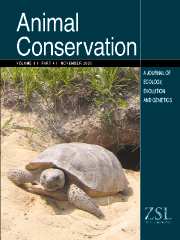Crossref Citations
This article has been cited by the following publications. This list is generated based on data provided by
Crossref.
Reed, David H.
Lowe, Edwin H.
Briscoe, David A.
and
Frankham, Richard
2003.
FITNESS AND ADAPTATION IN A NOVEL ENVIRONMENT: EFFECT OF INBREEDING, PRIOR ENVIRONMENT, AND LINEAGE.
Evolution,
Vol. 57,
Issue. 8,
p.
1822.
Reed, David H.
and
Hobbs, Gayla R.
2004.
The relationship between population size and temporal variability in population size.
Animal Conservation,
Vol. 7,
Issue. 1,
p.
1.
Reed, David H.
2004.
Extinction risk in fragmented habitats.
Animal Conservation,
Vol. 7,
Issue. 2,
p.
181.
Chan, Kung-Sik
Mysterud, Atle
Øritsland, Nils Are
Severinsen, Torbjørn
and
Stenseth, Nils Chr.
2005.
Continuous and discrete extreme climatic events affecting the dynamics of a high-arctic reindeer population.
Oecologia,
Vol. 145,
Issue. 4,
p.
556.
Robert, Alexandre
2006.
Negative environmental perturbations may improve species persistence.
Proceedings of the Royal Society B: Biological Sciences,
Vol. 273,
Issue. 1600,
p.
2501.
Winship, Arliss J.
and
Trites, Andrew W.
2006.
RISK OF EXTIRPATION OF STELLER SEA LIONS IN THE GULF OF ALASKA AND ALEUTIAN ISLANDS: A POPULATION VIABILITY ANALYSIS BASED ON ALTERNATIVE HYPOTHESES FOR WHY SEA LIONS DECLINED IN WESTERN ALASKA.
Marine Mammal Science,
Vol. 22,
Issue. 1,
p.
124.
Festa-Bianchet, Marco
Coulson, Tim
Gaillard, Jean-Michel
Hogg, John T
and
Pelletier, Fanie
2006.
Stochastic predation events and population persistence in bighorn sheep.
Proceedings of the Royal Society B: Biological Sciences,
Vol. 273,
Issue. 1593,
p.
1537.
Sibly, Richard M.
Barker, Daniel
Denham, Michael C.
Hone, Jim
and
Pagel, Mark
2006.
Response to Comment on "On the Regulation of Populations of Mammals, Birds, Fish, and Insects".
Science,
Vol. 313,
Issue. 5783,
p.
45.
ROBERT, Alexandre
COUVET, Denis
and
SARRAZIN, François
2007.
Integration of demography and genetics in population restorations.
Ecoscience,
Vol. 14,
Issue. 4,
p.
463.
Reed, David H.
Nicholas, Amy C.
and
Stratton, Gail E.
2007.
Inbreeding levels and prey abundance interact to determine fecundity in natural populations of two species of wolf spider.
Conservation Genetics,
Vol. 8,
Issue. 5,
p.
1061.
Reed, D. H.
Nicholas, A. C.
and
Stratton, G. E.
2007.
Genetic quality of individuals impacts population dynamics.
Animal Conservation,
Vol. 10,
Issue. 3,
p.
275.
Waite, T. A.
Campbell, L. G.
Chhangani, A. K.
and
Robbins, P.
2007.
La Niña's signature: synchronous decline of the mammal community in a ‘protected’ area in India.
Diversity and Distributions,
Vol. 13,
Issue. 6,
p.
752.
BRADSHAW, COREY J.A.
and
BROOK, BARRY W.
2007.
ECOLOGICAL‐ECONOMIC MODELS OF SUSTAINABLE HARVEST FOR AN ENDANGERED BUT EXOTIC MEGAHERBIVORE IN NORTHERN AUSTRALIA.
Natural Resource Modeling,
Vol. 20,
Issue. 1,
p.
129.
Tavecchia, Giacomo
Pradel, Roger
Genovart, Meritxell
and
Oro, Daniel
2007.
Density‐dependent parameters and demographic equilibrium in open populations.
Oikos,
Vol. 116,
Issue. 9,
p.
1481.
Waite, Tom A.
Chhangani, Anil K.
Campbell, Lesley G.
Rajpurohit, Lal S.
and
Mohnot, Surendra M.
2007.
Sanctuary in the City: Urban Monkeys Buffered against Catastrophic Die-off during ENSO-related Drought.
EcoHealth,
Vol. 4,
Issue. 3,
p.
278.
Virgós, Emilio
Cabezas-Díaz, Sara
and
Lozano, Jorge
2007.
Is the wild rabbit (Oryctolagus cuniculus) a threatened species in spain? Sociological constraints in the conservation of species.
Biodiversity and Conservation,
Vol. 16,
Issue. 12,
p.
3489.
Jiguet, F.
Robert, A.
Micol, T.
and
Barbraud, C.
2007.
Quantifying stochastic and deterministic threats to island seabirds: last endemic prions face extinction from falcon peregrinations.
Animal Conservation,
Vol. 10,
Issue. 2,
p.
245.
Tavecchia, Giacomo
Pradel, Roger
Genovart, Meritxell
and
Oro, Daniel
2007.
Density-dependent parameters and demographic equilibrium in open populations.
Oikos,
Vol. 116,
Issue. 9,
p.
1481.
O'Grady, J. J.
Reed, D. H.
Brook, B. W.
and
Frankham, R.
2008.
Extinction risk scales better to generations than to years.
Animal Conservation,
Vol. 11,
Issue. 5,
p.
442.
Virgós, Emilio
Cabezas-Díaz, Sara
and
Lozano, Jorge
2008.
Biodiversity and Conservation in Europe.
Vol. 7,
Issue. ,
p.
247.


